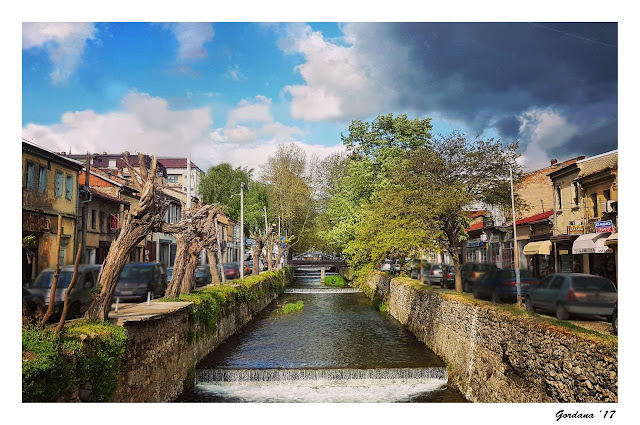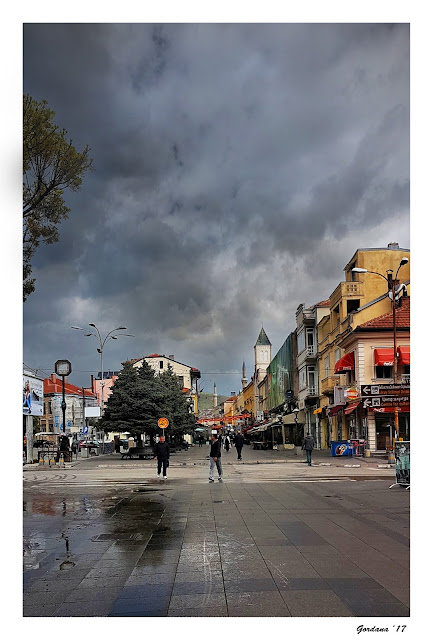Bitola - a town in southwestern Macedonia, administrative, cultural, economic, industrial, and educational center for that part of the country. The city is known as the city of consuls, because there were consular missions of the European countries at the time of the Ottoman Empire, where together with Solun (Thessaloniki), Bitola was the most important place in the European part of the empire. Today, many of the consular offices in the country are located here. Bitola is the second largest city in Macedonia according to the number of inhabitants. During Yugoslavia, Bitola was one of the cultural centers in the Kingdom of Yugoslavia, as well as in Yugoslavia. Father of the Turkish nation, Kemal Atatürk, attended officer school in Bitola. Some of his works are kept in the National Museum.
Etymology
Throughout history, depending on the rulers, Bitola had many names. According to Adrian Room, the Slavic name for the city, Bitola, comes from the word Monastery (Old Slavonic Obitѣlь) and this term today is used in Croatian language (Obitelj), which during the Middle Ages was used to name a community of monks, a family or monastery. Bitola was named after the many monasteries that were in town and in the surrounding area, and some of them still exist today. Over time, the voice O was disposed in the pronunciation of the word "Obitel" and the name of the city becomes Bitola. Greeks called the city Monastir (Greek: Μοναστήρι). Bitola is the present official name of the city, but also the oldest title, judging by Bitola plate from 1015 on which the city is mentioned, as well as according to many generals of the Emperor Samuel, and passengers at the time. Arab traveler Abu Abdallah Muhammad al-Idrisi in the XII century wrote: "It takes two days to travel east to reach the Ahrida (Ohrid) and Butyl (Bitola). Butyl is unusual and beautiful city. "
There are tales that on the right bank of the river Dragor were 41 churches and the same number of mills for maintaining the churches. Also on the left bank of the Dragor there were 29 churches with 29 mills. During the holidays at this time, people from the villages of Bitola area gathered in those churches where they performed their religious rites. Since the land on which was located the city of Bitola was then covered with numerous monasteries, the city was named Monastery.
According to the written records of Marco Cepenkov Bitola was named after some rich man named Toljo, who had his fortress near the village Bukovo. At the time when the Turks came to conquer this part of Macedonia, they called him saying "Bi Toljo, Bi Toljo" which according to Marko Cepenkov is where the current name of the city of Bitola comes from.
During Ottoman rule, the city was called Monastery, which Turks and Albanians adopted from the Greeks. After the Balkan Wars in 1913, the city falls under Serb occupation and again receives the old name Bitola.
History
Many important events in Macedonian and Balkan history took place in Bitola. The city was built, rebuilt, damaged and re-built and upgraded since its first settlement in the Late Bronze Age. Then in the Hellenistic period and the Roman Empire, until the Byzantine time, had the status of a town with a high degree of civilization.
Traditionally the strong commercial center, is known as the city of consuls because at one point during the Ottoman Empire, Bitola had even twenty consulates from various European countries. In the same period, the city had many schools, among others, the military academy, which attended the famous Turkish reformer Kemal Ataturk. At the end of the XIX century, Bitola was so powerful city, that its population constantly grew and exceeded the population of Belgrade. The city was crowded with factories and photographic shops and the interesting part is that despite Singer in Bitola, even at that time there was a factory for sweets in Bitola. Bitola recorded the first photos and movies thanks to the brothers Manaki. It was the golden age of the city. Unfortunately, during the Balkan wars, many battles were driven around the city and in the city itself, so, many physical evidences were burned or were completely destroyed. The architecture was recovered, especially in the last fifteen years, and evidence of everything that happened are the stories from the elders who remember well what happened.
To be continued...
 |
| View of Magnolia Square with the monument of Philip II of Macedonia - the founder of Bitola and the famous clock tower in the background, photo by Gordana Adzieva-Mihajlovska |
Throughout history, depending on the rulers, Bitola had many names. According to Adrian Room, the Slavic name for the city, Bitola, comes from the word Monastery (Old Slavonic Obitѣlь) and this term today is used in Croatian language (Obitelj), which during the Middle Ages was used to name a community of monks, a family or monastery. Bitola was named after the many monasteries that were in town and in the surrounding area, and some of them still exist today. Over time, the voice O was disposed in the pronunciation of the word "Obitel" and the name of the city becomes Bitola. Greeks called the city Monastir (Greek: Μοναστήρι). Bitola is the present official name of the city, but also the oldest title, judging by Bitola plate from 1015 on which the city is mentioned, as well as according to many generals of the Emperor Samuel, and passengers at the time. Arab traveler Abu Abdallah Muhammad al-Idrisi in the XII century wrote: "It takes two days to travel east to reach the Ahrida (Ohrid) and Butyl (Bitola). Butyl is unusual and beautiful city. "
There are tales that on the right bank of the river Dragor were 41 churches and the same number of mills for maintaining the churches. Also on the left bank of the Dragor there were 29 churches with 29 mills. During the holidays at this time, people from the villages of Bitola area gathered in those churches where they performed their religious rites. Since the land on which was located the city of Bitola was then covered with numerous monasteries, the city was named Monastery.
 |
| River Dragor |
During Ottoman rule, the city was called Monastery, which Turks and Albanians adopted from the Greeks. After the Balkan Wars in 1913, the city falls under Serb occupation and again receives the old name Bitola.
History
Many important events in Macedonian and Balkan history took place in Bitola. The city was built, rebuilt, damaged and re-built and upgraded since its first settlement in the Late Bronze Age. Then in the Hellenistic period and the Roman Empire, until the Byzantine time, had the status of a town with a high degree of civilization.
 |
| Shirok Sokak (famous promenade in Bitola) |
Traditionally the strong commercial center, is known as the city of consuls because at one point during the Ottoman Empire, Bitola had even twenty consulates from various European countries. In the same period, the city had many schools, among others, the military academy, which attended the famous Turkish reformer Kemal Ataturk. At the end of the XIX century, Bitola was so powerful city, that its population constantly grew and exceeded the population of Belgrade. The city was crowded with factories and photographic shops and the interesting part is that despite Singer in Bitola, even at that time there was a factory for sweets in Bitola. Bitola recorded the first photos and movies thanks to the brothers Manaki. It was the golden age of the city. Unfortunately, during the Balkan wars, many battles were driven around the city and in the city itself, so, many physical evidences were burned or were completely destroyed. The architecture was recovered, especially in the last fifteen years, and evidence of everything that happened are the stories from the elders who remember well what happened.
To be continued...












No comments: